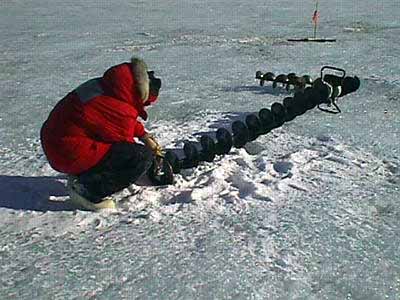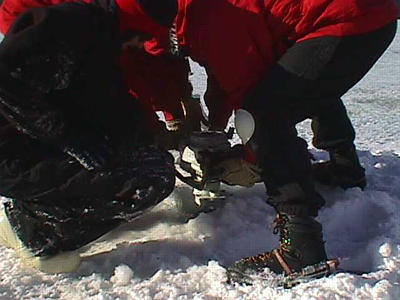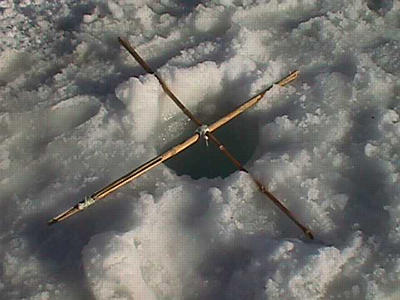
|
|
6 November, 1998
Lots of wind again this morning, but my tent is holding up very well. I
woke up at about 8:00 am. The sun peeks around the mountains earlier
and earlier every morning. Someone said that the sun changes position
very rapidly here...meaning that, at any parcticular time, the sun's
position is 20 minutes ahead of where it was yesterday. It's light out
all of the time, but since we're down in a valley, the sun goes behind
the mountains during the evening.
We ate breakfast in shifts...as people woke up and straggled into the
Jamesway. Since John was working on a problem with the data logger and
wouldn't be able to help me drill my 10-inch diameter hole in the ice
(actually 4.5 meters down), Chris explained how he wanted the land
sediment sampling to be done (so I could get started on that).
Basically, he wanted me to pick an area that was about 400 meters from
camp, about 200 meters past the weather station. I would be doing a
soil transect, measuring off 50 meters up the hill, perpendicular to the
lake. At the 25 meter point, I was to measure off another 25 meters to
the left or right, sort of forming a "T" shape on the hill. I would be
taking samples of soil at every 5 meters along those two lines, the
samples consisting of only the top 2 cm of soil (because that soil is
the most transportable of all of the soils...the most wind-exposed). I
would bag the samples up and use them later in experiments at McMurdo.
Chris also wanted to try a little micro-sampling...in between 10 and 20
meters and 30 and 40 meters, I took a few more samples so that we could
compare differences in C/N/H (Carbon, Nitrogen, and Hydrogen) within
samples that were closer together.
It took me about 45 minutes to label my bags and gather the measuring
tape, the bamboo flags, the water, and snacks that I would need...the
latter being the most important! : ) Once out on the hill, it took me
about 2 hours to gather the samples. I took pictures of the sampling
area and closeup pictures of each 5 meter spot to document what I did.
After returning to the Jamesway and getting a little lunch, I realized
John was still working on the data logger problem. He mentioned that
the LTER team might be willing to help me drill my ice hole, so I walked
out onto the ice to where they were. They were in a small red hut on
the ice, drilling a sample hole in the ice. They drill their holes in
these small huts so that their holes don't freeze back up quickly.
To make a long story short, they agreed to help me drill my sediment
trap hole in the ice. It took about 1-1/2 hours of drilling to get
through the ice! We each held on to either end of a power head attached
to a long, 10-inch diameter drill bit about 1 meter long. As soon as
that drill bit went through the ice, we had to pull the power head up
and attach another drill bit extension...and so on, until we got through
the ice (about 4.5 meters). I couldn't believe how much jarring I got
drilling. I was on the throttle, so I had to make sure that I kept it
going...there was danger of stalling, and if the power head quits while
drilling, the drill could freeze into the ice (uuuggghhh!...and then
we'd have to drill another hole next to the original hole and melt it
out). Not fun, I've heard! Anyway, I survived until the last minute
when we got to the water. The drill became very heavy, and we needed
help...so Laura and Chris helped us clear the water out (by repeatedly
pushing and pulling the drill out of the hole). Whew!...and these guys
said there were times that they did 7-8 of these in a day! Needless to
say, I was very tired, and I'm sure the LTER team was regretting the
decision to help me out...
I poured my NaCl/Formalin solution in the bottom of the sample bottle of
the sediment trap and, with Craig's help, lowered the trap into the
hole. There was a bit of slush collection in the first meter of water,
and even with a 15 lb. weight at the bottom of the trap, it refused to
go down. We cleared some of the slush out with a single drill bit, and
then the trap went down quite rapidly. The "X"-shaped bamboo poles at
the top prevented the whole trap from disappearing down the hole. Now I
have to check the trap in 5-6 days. I hope it doesn't completely freeze
back up.
We had dinner (John and Kathy had fixed halibut steaks, rice, cajun
shrimp, and green beans...yum!), and I helped with dishes cleanup.
Tomorrow morning Chris, John, and Nina are going to Lake Fryxell to
gather more ice core samples (I'm doing another soil transect on Lake
Bonney), and tomorrow afternoon Chris and I fly out to McMurdo to take
the samples we've gathered back into the freezers at McMurdo. We don't
want to lose what we have already collected.
Bedtime came earlier tonight (10:30 pm) because of the early helicopter
pickup for part of our team tomorrow. I know I'll sleep well tonight!
Just give me my hot water bottle for the bottom of my sleeping bag, and
I'm set. : ) If my husband were here, I'd be even happier!

Craig (right) and I (left) drilling a 10-inch diameter hole in the ice for the sediment trap. This is tough work!

I'm checking the drill bit while Craig goes to find a wrench. Sometimes the drill bit needs to be adjusted a little because it stops "cutting" as well as it should. Note how long the drill is already (and we're still not down to water!).

You might be able to see a little water coming out of the hole. I'm in the black fleece and windpants (I got a little warm while drilling). Laura, Craig, and Chris are the others on the drill. The whole device got very heavy when we hit water.

Here we are-- Laura, me, and Craig-- getting ready to lower the sediment trap into our ice hole. It's a little blurry, but I had to show you what the trap looked like. At the bottom of the yellow cone is a small 125-ml collection bottle, and that's where the sediment will collect.

This is the bamboo "X" I was talking about. This prevents the whole trap from disappearing down the hole and allows me to retrieve it later (in 5 - 6 days).
Contact the TEA in the field at
.
If you cannot connect through your browser, copy the
TEA's e-mail address in the "To:" line of
your favorite e-mail package.
|
